![]()
![]()
![]()
Use LEFT and RIGHT arrow keys to navigate between flashcards;
Use UP and DOWN arrow keys to flip the card;
H to show hint;
A reads text to speech;
14 Cards in this Set
- Front
- Back
|
Basic principles of bridge design |
* safe * applicable *economical * beautiful * environmentally friendly. |
|
|
Basic requirements of bridge design |
(1) Structure size and structure: *Strength: adequate safety reserves *Stiffness: Control of deformation *Stability: The ability to maintain the original shape and position 2. Requirement for use:Applicable and durable * Guaranteed to be used normally during the 100-year design period;* The bridge deck width meets the traffic flow within the current and future planning years.*Conducive to flood discharge. navigation (cross-river bridge) or the passage of vehicles and pedestrians (dry bridge): *Both ends of the bridge facilitate the entry and evacuation of the vehicle:*Consider comprehensive utilization to facilitate the loading of various pipelines 3. Economic requirements: Reasonable economy *Select the most cost-effective bridge type for cost and maintenance costs, *Follow the principles of local conditions, local materials and convenient construction; *The bridge should be considered to shorten the transportation distance between the two sides of the river, to promote the economic deveelopment of the region... (4) Construction requirements: advanced technology *Under the premise of adapting to local conditons mature new structures, new equipment, new materials and new processes should be used as much as possible 5. Aesthetic and landscape requirement: beatiful The bridge can easily give pepoles psychological hopes of reaching the other side, and is also an impressive landmark, and often becomes an aesthetic object and cultural heritage 6. Environmental protection nd sustanable development Considering environmental requirements in many aspsects, taking necessary engineering control measures, establishing an environmetal monitoring and protection system to minimize adverse effects |
|
|
1. Plane of bridge |
a. Determine the bridge position- The positiont and line shape of the small bridge and culvert should generally conform to the general direction of the route.-To meet the requirement of hydrology and line bends, diagonal bridges and curved bridges can be designed, for the special bridges, large and medium bridges- In princple, the bridge should obey the route, comprehensive consideration of bridegs and roads and try to choose river sections where the rivers are straight, the water flow is stable and the geology is good.- The flat curve radius of the bridge, the flat curve superelevaton and widening, the easing curve, the shift lane setting etc., should all meet the requirements of the corresponding grade line. |
|
|
2. Longitudinal section of the bridge |
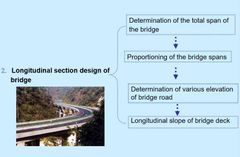
|
|
|
Determination of total span |
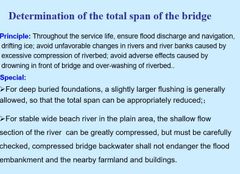
|
|
|
Bridge navigation hole |
*Principle: Under the premise of meeting the requirement of use and technology, the total cost of the upper and lower structure is minimized Use and technical requirements(1)Navigable rivers: The navigation requirements under the bridgeshould be met. Navigation holes should be placed in the most convenient river area for navigation. For transitional rivers, depending on the specific conditions, several navigation holes should be provided..(2) Bridges on wide rivers in the plain area: Generally, larger navigation holes are arranged as needed in the main river channel. and sub-holes are made according to economic spans on the shoal parts on both sides. (3) For rivers that are deep in the mountains and deep in the water, or when building bridges on the reservoir, the span should be increased, and even a single hole. (4)Reasonably determine the ratio between adjacent spans considering the force characteristics of the structure. (5) lt is possible to appropriately increase the span to avoid unfavorable geological sections. (6) The situation of the upstream and downstream adjacent to the bridge. |
|
|
Longitudinal slope of bridge deck |
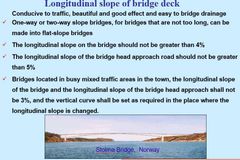
|
|
|
Transverse cross section |
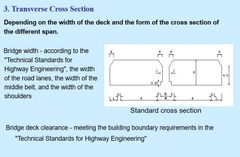
|
|
|
Bridge design and construction procedures |

|
|
|
Design procedures |
1.Preliminary design: to determine the design of the bridge *Further development of hydrology and survey work *Comparison of bridge schemes * Scientific research projects*Construction organization design * Estimate2. Technical designFurther deepen the preliminary design: fully explore, determine the detasize section reinforcement. determine the construction method, adjust the budget estimate(Technically complex bridges, interchanges, or new bridge structures) 3. Construction designPrepare construction drawings and prepare project budgets |
|
|
Comparison of bridge design scheme |
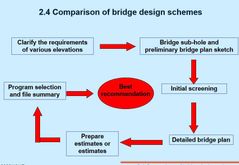
|
|
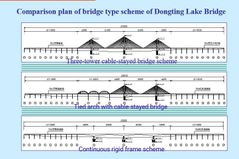
|
Advantages and disadvantagesServiceability:Scheme I:Three-tower cable-stayed bridge scheme *The main span of the two holes 310m spans the main channel, and has good adaptability to the navigation channel. The navigation clearance is large and the anti-corrosion reguirements are low;*The river bed has less compression, which is beneficial to flood discharge during flood season; *(There are many expansion joints of 50m simple support T-beams in the West Bank, and the bridge deck is continuous and easy to crack.) Scheme II:Tied arch with cable-stayed bridge *50m continuous beam in the West Bank sub-hole, less expansion joints *The pier has higher requirements for collision avoidance;*The riverbed is more compressed, which is more unfavorable for flood discharge during flood season; *The main bridge has fewer spans, which is more unfavorable for navigation Scheme III: Continuous rigid frame scheme1. The two-hole 280m span continuous rigid frame spans the main channe and has good adaptability to the navigation channel. The navigation clearance is large and the anti-collision requirements are low;2.The riverbed is much compressed, and the flood discharge capacity during the flood season is poor;3.The 50m hollow slab of the West Bank sub-hole has many expansion joints and the bridge deck is continuously cracked. |
|
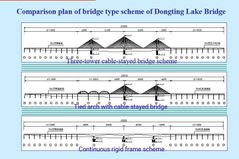
Safety |
Advantages and disadvantagesSafety:Scheme I:Three-tower cable-stayed bridge scheme1.The main bridge spans moderately, and the plate-beam structure is convenient to construct and the construction period is short;2.The West Bank auxiliary hole adopts prefabricated T-beam, which can be factory-prefabricated and constructed with reliable quality and guaranteed constructionperiod.but reauires large prefabrication vards and lifting equipment;3.The maintenance cost of the main bridge is relatively high4. Smoother driving
Advantages and disadvantagesSafety:Scheme II:Tied arch with cable-stayed bridge1.The main body adopts the box girder section, which has high rigidity and safe construction;2.The West Bank auxiliary hole is cast in place with the mobile support, the construction conditions are poor, the construction period has many constraints and more sets of equipment are required to ensure the construction period;3.The maintenance cost of the main bridge is relatively high;4. Smooth and comfortable driving
Advantages and disadvantagesScheme IIl: Continuous rigid frame scheme1.The main span of280m continuous rigid frame is the largest span in the world, with difficult construction and long construction period;2.The West Bank auxiliary hole adopts prefabricated empty board.whichcanbefactory-prefabricated and constructed with reliable quality and quaranteed construction period. However, prefabrication and lifting equipment are required;3.The maintenance cost of the main bridge in the later period is small4. Smooth and comfortable driving. |
|

Aesthetic |
Advantages and disadvantagesAesthetic:Scheme I:Three-tower cable-stayed bridge schemeThe bridge is beautiful, magnificent, and well coordinated with the surrounding environment. Scheme II:Tied arch with cable-stayed bridgeTowering pylons and low arches, large-span bridges and small-span arch bridges have obvious contrasts, uncoordinated, and bridge-like Scheme III: Continuous rigid frame schemeThe main bridge line is simple and clear, but because of its high span ratio is not very harmonious, affecting the bridge shape |

